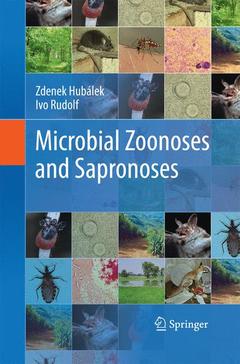Description
Microbial Zoonoses and Sapronoses, 2011
Authors: Hubálek Zdenek, Rudolf Ivo
Language: English
Subject for Microbial Zoonoses and Sapronoses:
Microbial Zoonoses and Sapronoses
Publication date: 10-2014
457 p. · 15.5x23.5 cm · Paperback
Publication date: 10-2014
457 p. · 15.5x23.5 cm · Paperback
Microbial zoonoses and sapronoses
Publication date: 11-2010
457 p. · 15.5x23.5 cm · Hardback
Publication date: 11-2010
457 p. · 15.5x23.5 cm · Hardback
Description
/li>Contents
/li>Comment
/li>
This book presents the state of art in the field of microbial zoonoses and sapronoses. It could be used as a textbook or manual in microbiology and medical zoology for students of human and veterinary medicine, including Ph.D. students, and for biomedicine scientists and medical practitioners and specialists as well. Surprisingly, severe zoonoses and sapronoses still appear that are either entirely new (e.g., SARS), newly recognized (Lyme borreliosis), resurging (West Nile fever in Europe), increasing in incidence (campylobacterosis), spatially expanding (West Nile fever in the Americas), with a changing range of hosts and/or vectors, with changing clinical manifestations or acquiring antibiotic resistance. The collective term for those diseases is (re)emerging infections, and most of them represent zoonoses and sapronoses (the rest are anthroponoses). The number of known zoonotic and sapronotic pathogens of humans is continually growing ? over 800 today. In the introductory part, short characteristics are given of infectious and epidemic process, including the role of environmental factors, possibilities of their epidemiological surveillance, and control. Much emphasis is laid on ecological aspects of these diseases (haematophagous vectors and their life history; vertebrate hosts of zoonoses; habitats of the agents and their geographic distribution; natural focality of diseases). Particular zoonoses and sapronoses are then characterized in the following brief paragraphs: source of human infection; animal disease; transmission mode; human disease; epidemiology; diagnostics; therapy; geographic distribution.
1.- Introduction.- 2. Types of human disease by source of the infectious agent.- 3. A history of zoonoses and sapronoses and research into them.- 4. The infection process in zoonoses and sapronoses .- 4.1. Infectious agent.- 4.2. Infection entry.- 4.3. Infection course and host defence.- 5. The epidemic process in zoonoses and sapronoses.- 5.1. Characteristics of the epidemic process.- 5.2. External factors in the epidemic process.- 5.3. Natural focality of diseases.- 5.4. Epidemiological examination in the focus of an infectious disease.- 5.5. Epidemiological surveillance.- 5.6. The control of zoonoses and sapronoses.- 6. Haematophagous arthropods as vectors of diseases.- 6.1. Characteristics of transmission of infections by arthropods.- 6.2. A survey of haematophagous vectors of microbial diseases.- 6.3. A list of microbial agents transmitted by vectors.- 7. Vertebrates as hosts and reservoirs of zoonotic microbial agents.- 7.1. Mammals (Mammalia).- 7.2. Birds (Aves).- 7.3. Reptiles (Reptilia).- 7.4. Amphibians (Amphibia).- 7.5. Fishes (Pisces).- 8. Systematic survey of zoonotic and sapronotic microbial agents.- 8.1. Prions.- 8.2. Viruses.- 8.3. Bacteria.- 8.4. Fungi.- 8.5. Protozoa.- 8.6. Other eucaryotic microorganisms.- 9. Literature.- 10. Index.
Presents short characteristics are given of infectious and epidemic process, including the role of environmental factors, possibilities of their epidemiological surveillance, and emphasis on ecological aspects of these diseasesincludes source of human infection; animal disease; transmission mode; human disease; epidemiology; diagnostics; therapy; geographic distribution.
© 2024 LAVOISIER S.A.S.




